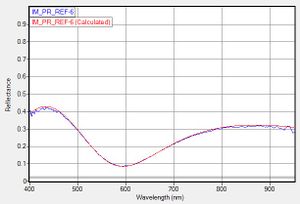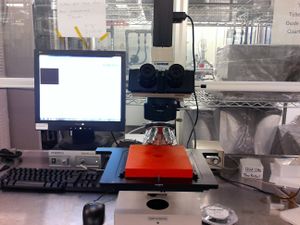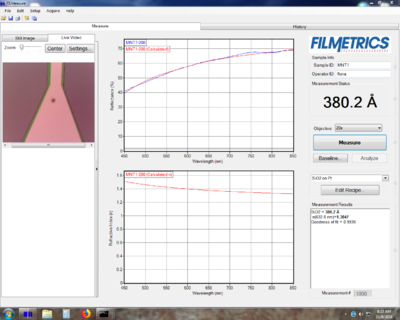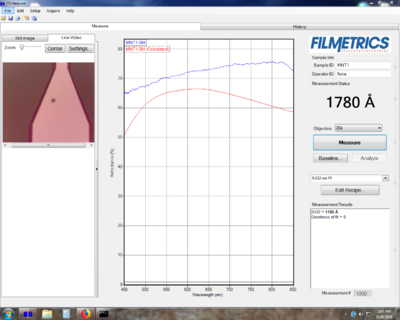Filmetrics F40-UV Microscope-Mounted: Difference between revisions
→Screenshots + Examples: Added example of inspecting for SiO2 dry-etch completion. |
→Good Curve-Fitting: explained reasonable vs. perfect curve fit |
||
| (10 intermediate revisions by 2 users not shown) | |||
| Line 1: | Line 1: | ||
{{ |
{{tool2 |
||
|super = |
|super = Aidan Hopkins |
||
|super2= Demis D. John |
|||
|picture=Filmetrics F40-UV - system pic 01.jpg |
|picture=Filmetrics F40-UV - system pic 01.jpg |
||
|type = Inspection, |
|type = Inspection, Test and Characterization |
||
|location = Bay #4 |
|location = Bay #4 |
||
|description = Microscope-mounted optical reflectometry |
|||
|description = Measures surface topography, step heights and roughness with white-light interferometry. |
|||
|manufacturer = Filmetrics Inc. |
|manufacturer = Filmetrics Inc. |
||
|model = F40-UV |
|model = F40-UV |
||
}} |
}} |
||
== |
==About== |
||
The Filmetrics F40-UV is a microscope-mounted thin-film measurement system, allowing you to non-destructively measure thin-film thicknesses in small (patterned) areas on your sample. It is an optical reflectometer, acquiring reflection spectra between 400-900nm optical wavelengths (Vis to Near-IR) with a regular halogen microscope light source. The Filmetrics software then performs curve-fitting to determine the thickness and/or refractive index of the measured films. |
The Filmetrics F40-UV is a microscope-mounted thin-film measurement system, allowing you to non-destructively measure thin-film thicknesses in small (patterned) areas on your sample. The microscope is a standard Olympus BHJML metallurgical trinocular microscope. It is an optical reflectometer, acquiring reflection spectra between 400-900nm optical wavelengths (Vis to Near-IR) with a regular halogen microscope light source. The Filmetrics software then performs curve-fitting to determine the thickness and/or refractive index of the measured films. |
||
== |
==Capabilities== |
||
| ⚫ | |||
| ⚫ | |||
| ⚫ | |||
| ⚫ | |||
| ⚫ | |||
| ⚫ | |||
| ⚫ | |||
| ⚫ | |||
| ⚫ | |||
**Can measure thin-films in few-micron spot. |
|||
| ⚫ | |||
| ⚫ | |||
| ⚫ | |||
*Approx ≥20nm film transparent measurement up to tens of microns. |
|||
| ⚫ | |||
| ⚫ | |||
| ⚫ | |||
| ⚫ | |||
| ⚫ | |||
| ⚫ | |||
===Good Curve-Fitting=== |
|||
| ⚫ | Do not believe your thickness measurements unless the red/blue curves show a reasonably good match![[File:Filmetrics_F40-UV_-_Measurement_screenshot_on_metal_pad_01.PNG|alt=example spectrum curve fit|none|thumb|500x500px|Screenshot showing 10x microscope view and optical spectrum/curve fitting of the SiO2 film thickness on top of Platinum contact metal. This is considered a "reasonable" fit because the curves are very similar, but don't overlay perfectly, giving only reasonable confidence in the reported numbers.]] |
||
| ⚫ | |||
| ⚫ | |||
The F40-UV is very useful for measuring whether a thin-film has been completely removed during a dry etch. This is similar to using [[Laser Etch Monitoring|laser monitoring]] during the etch, except that the microscope enables you to measure inside small patterned areas that a laser monitor spot may not fit inside. |
|||
In the following example, we are trying to etch away the SiO<sub>2</sub> from on top of a Platinum contact metal. The 20x objective allows us to measure the SiO2 thickness on top of the Platinum as we continue to etch in 1 minute increments, measuring in between etches. |
|||
Finally, when the SiO2 has been fully removed, we see that we can't get a good fit between the measured (blue) and simulated (red) data. |
|||
Since the Platinum layer is thick enough to be opaque to visible light (>50nm), we just modelled this as SiO2 on top of Platinum, ignoring any other materials below the platinum. |
|||
{| class="wikitable" |
{| class="wikitable" |
||
|+ |
|||
| ⚫ | |||
![[File:Filmetrics F40-UV - SiO Etch 4m+4m - Incomplete Etch.png|alt=Example Screenshot of incomplete SiO2 etch|none|thumb|400x400px|Incomplete Dry-Etch, showing some residual SiO2 left.]] |
![[File:Filmetrics F40-UV - SiO Etch 4m+4m - Incomplete Etch.png|alt=Example Screenshot of incomplete SiO2 etch|none|thumb|400x400px|Incomplete Dry-Etch, showing some residual SiO2 left. "Goodness of Fit" is close to 1.0 in the results pane, and the red+blue curves match closely so we believe the measurement.]] |
||
![[File:Filmetrics F40-UV - 2018-11-08 - SiO Etch 4m+4m+1m - Fully Removed.png|alt=Example screenshot of fully removed SiO2 etch|none|thumb|400x400px|After re-etching, measurement shows bad fit (red and blue curves), |
![[File:Filmetrics F40-UV - 2018-11-08 - SiO Etch 4m+4m+1m - Fully Removed.png|alt=Example screenshot of fully removed SiO2 etch|none|thumb|400x400px|After re-etching, measurement shows bad fit (red and blue curves), and "Goodness of Fit" = 0 in the results pane. |
||
The thickness value shown is not real, and this indicates that the SiO2 film has been fully removed since no parameter can give a good fit. |
|||
]] |
|||
|} |
|} |
||
==Other Info== |
|||
'''''Equip > Characterization > <u>[[Microscopes]]</u>''''' - ''see a list of all our microscopes'' |
|||
Latest revision as of 21:28, 29 September 2022
| ||||||||||||||||||||||||||||
About
The Filmetrics F40-UV is a microscope-mounted thin-film measurement system, allowing you to non-destructively measure thin-film thicknesses in small (patterned) areas on your sample. The microscope is a standard Olympus BHJML metallurgical trinocular microscope. It is an optical reflectometer, acquiring reflection spectra between 400-900nm optical wavelengths (Vis to Near-IR) with a regular halogen microscope light source. The Filmetrics software then performs curve-fitting to determine the thickness and/or refractive index of the measured films.
Capabilities
- Measure optically transparent thin-films down to ~30nm thickness.
- Microscope Objectives: 10x, 20x, 50x, 100x, 150x
- Can measure thin-films in few-micron spot.
- Acquire Optical Reflection Spectra from 400-900nm
- Spectrometer/Detector is capable of detecting down to UV ~190nm, but light source does not support this wavelength.
- Reflectivity curve-fitting for thin-film thickness analysis, supporting many common materials (Si3N4, SiO2 dielectrics, Si, GaAs, InP semiconductors, metals, photoresists etc.)
- Approx ≥20nm film transparent measurement up to tens of microns.
Operating Procedures
Examples
Good Curve-Fitting
Do not believe your thickness measurements unless the red/blue curves show a reasonably good match!


Checking whether a dry etch is complete
The F40-UV is very useful for measuring whether a thin-film has been completely removed during a dry etch. This is similar to using laser monitoring during the etch, except that the microscope enables you to measure inside small patterned areas that a laser monitor spot may not fit inside.
In the following example, we are trying to etch away the SiO2 from on top of a Platinum contact metal. The 20x objective allows us to measure the SiO2 thickness on top of the Platinum as we continue to etch in 1 minute increments, measuring in between etches.
Finally, when the SiO2 has been fully removed, we see that we can't get a good fit between the measured (blue) and simulated (red) data.
Since the Platinum layer is thick enough to be opaque to visible light (>50nm), we just modelled this as SiO2 on top of Platinum, ignoring any other materials below the platinum.
Other Info
Equip > Characterization > Microscopes - see a list of all our microscopes


